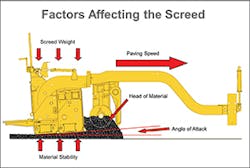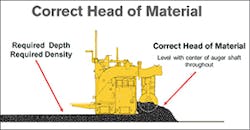Subbing a rookie for a veteran the moment before a championship game is ill advised—no matter how promising the rookie. Why take a risk in such a high-stakes moment? After all, if it ain’t broke, don’t fix it.
This old adage is a mindset that stands true in asphalt road building—a job that requires coordination akin to an Olympic baton handoff between the paver and compactor operators. New and unfamiliar technologies are often met with some reluctance on the part of road contractors—but by coupling well-established best practices with some of these emerging technologies, road contractors have an opportunity to not only improve work quality, but to be significantly more profitable.
Road quality has been linked to a contractor’s bottom line since the late 19th century, when New York City first required warranties on its newly laid asphalt roads. In the past decade, a plethora of new tools have debuted with the potential to help road builders provide the best product more efficiently. Recent examples include speed limiters, automatic feed systems, high-frequency rollers, and intelligent compaction (IC) systems—each met with varying degrees of resistance from contractors upon their introduction, but each tied to higher-quality work. Let’s take a look at some of these recent advancements in the context of well-established and accepted road building best practices.
Smooth Sailing for Pavement
Material level and paver speed both play a significant role in determining pavement quality. The two most important factors for laying a quality mat are all about consistency: consistent head of material in front of the screed and consistent paving speed.
More than 95% of all material faults in asphalt paving are due to an improper “head of material” in front of the screed. The head of material is the mass of paving mix that lies directly in front and spans the width of the screed. While monitoring material levels is the responsibility of the screed operator, many machines are now equipped with automatic feed systems that use sensors to regulate the proper delivery and flow of material in front of the screed to ensure smooth and consistent paving. These small advances can make a big difference, and acceptance of these technologies has been rather steady.
Ripples, waves, and irregular mat depth can occur when paving speed doesn’t remain constant. In an ideal paving operation, the paver will operate nonstop throughout the day, because a change in paving speed can directly affect the ability to lay a uniform mat. Speed changes also create challenges with timing the delivery of hot mix material in order to keep the hopper at least one-third full. Consequently, changes in paving speed are commonly caused by trucks inconsistently arriving at the job site, or bumping the paver during the truck exchange.
When setting the paving speed, consider the number and size of trucks, volume, and output of the mixing plant, rolling and compaction rates, and crew capabilities, plus the distance from the mixing plant to the paver. Speed limiters, similar to an automobile’s cruise control, are available on some paver models to control paving speed. The paving industry has seen improvements in efficiency and mat quality thanks to these simple technologies. It’s easy to see their value, particularly when implementation costs are minimal and they’re simple to use. The same can’t necessarily be said for some of the recent advancements incompaction technology.
Technology to Improve Compaction
Pavement must cope with unexpected loads, heavy traffic and—depending on location—harsh winters. Compaction best practices will preserve asphalt integrity and delay the need for road maintenance. Three of the primary factors that impact the quality of compaction are mat temperature, compactor rolling patterns, and mat density—each of which can be monitored in real time with recent advancements in IC technology. But not all IC systems are created equal, and there is undoubtedly a need for a great deal of education and training on the subject before mass adoption occurs.
IC systems feature an accelerometer-based measurement system, as well as GPS, infrared temperature sensors, and an on-board computer that provides real-time compaction information to the operator. The primary features of IC systems—common among most providers—are pass mapping, surface temperature mapping, and data collection.
- Pass mapping: IC systems provide real-time information to the operator, showing how many passes have been completed and ensuring the operator can gain better uniformity across 100% of the mat. Over-compaction is equally as detrimental to quality as under-compaction, and pass mapping can help ensure the operator isn’t making too many or too few passes. In general, there should be a prescribed number of passes for a job (rolling pattern), but that number of passes only achieves target density if compacting is done at the correct asphalt temperature and at the correct amplitude settings.
- Temperature mapping: IC systems display real-time pavement surface temperature information to the operator. This is incredibly important, as the temperature greatly impacts the material’s ability to be compacted. Armed with real-time temperature information, a skilled compactor operator will know to make adjustments to the distance behind the paver in order to compact the asphalt at peak temperatures and avoid the need for additional passes that can drive up project costs and extend timelines.
- Data collection: The Federal Highway Administration (FHWA) recognized that IC data could provide significant value for quality control protocols. Of critical importance, however, was ensuring that data was collected and reported in a standard format among all manufacturers’ IC systems. Thus, the FHWA recommended that all systems export data in a standard format for use in a program called Veta—a map-based software originally funded by both FHWA and Minnesota Department of Transportation (DOT).
While these three features are more or less standard across all IC systems, what varies between systems is how the asphalt intelligent compaction measurement value (ICMV) is calculated—a value that is meant to help contractors estimate density based on stiffness. The majority of IC systems offer real-time asphalt ICMV calculations; however, each manufacturer has a slightly different methodology for how it’s done. Despite the variance in calculations between manufacturers, each has the same goal in mind—to equate ICMV to density. This correlation (or lack thereof) between ICMV calculations and real-world asphalt density values has been subject to a great deal of scrutiny in the past several years, which ultimately has contributed to the lack of adoption and level of skepticism among contractors.
FHWA Findings: ICMV Not Density
In 2014, FHWA released a report about a study that attempted to identify a clear correlation between ICMV calculations and in-place asphalt densities. The study involved IC testing and evaluation on asphalt paving projects throughout Utah, Florida, Ohio, Maine, California, Idaho, Maryland, Kentucky, and Washington.The FHWA evaluated the ICMV calculations of IC systems from manufacturers including Hamm, BOMAG, Caterpillar, and Sakai. These calculations were then compared to actual asphalt density values from core samples. After two years of testing and evaluation, the FHWA released a 321-page report, “A Study on Intelligent Compaction and In-Place Asphalt Density,” in December 2014 outlining their findings.
The report found that ICMV values alone cannot reliably predict core densities, stating, “The pass-by-pass ICMV correlate well with nuclear density gauge measurements during breakdown compaction. The final ICMV does not correlate well with core densities.”
Numerous factors are cited in the lack of correlation, including measurement depths, footprints, and a change in drum rebounds when asphalt temperatures drop below a certain threshold. The report does, however, insist that IC systems “can be used as an enhanced tool for quality control by monitoring ICMV in real time during construction in order to maximize the window of opportunity for compaction.”
A Turn in the Tides: Real-Time Density
In 2008, the FHWA devoted $200,000 under the Highways for LIFE Technology Partnerships program with the University of Oklahoma (owner of multiple patents for this technology) for studying an alternative method of determining density. Originally termed Intelligent Asphalt Compaction Analyzer (IACA), this technology is what eventually came to be named Volvo Density Direct.
This technology has been licensed to Volvo by the University of Oklahoma and integrated into the newly available Volvo IC system. As with other IC systems, Volvo IC with Density Direct offers surface temperature mapping, pass mapping, and data collection capabilities. However, the Volvo system offers the added benefit of real-time density calculations. At the touch of a screen, the compactor operator can see real-time density information (not stiffness information) across 100% of the mat. When properly calibrated against actual cores from a test strip on the project, Density Direct provides real-time estimated density values that have been proven to be within 1.5% accuracy of actual in-place density, allowing the operator to make informed decisions on the fly.
States With IC Requirements
- Alaska
- Arizona
- California
- Washington DC
- Georgia
- Indiana
- Iowa
- Kentucky
- Michigan
- Massachusetts
- Minnesota
- Nevada
- New Jersey
- New Mexico
- North Carolina
- Oklahoma
- Pennsylvania
- Rhode Island
- Tennessee
- Texas
- Utah
- Vermont
Challenges Remain, But Opportunity Awaits
FHWA-funded testing programs are continuing to work toward proving the value of IC technology, and, subsequently, many state DOTs see the value and have begun mandating the use of these IC systems on certain federal- and state-funded projects. As of October 2015, a total of 22 states have implemented, tovarying degrees, IC specifications. Despite its merit on paper—and the push from FHWA and state DOTs—familiarity and acceptance among contractors is still relatively low, and education and training opportunities will be vital to adoption. Fortunately, the number of IC resources and training opportunities continues togrow, and curious contractors have plenty of places to turn.
Setting Up Shop
The FHWA has supported the development of IC technology and led a variety of efforts to train contractors. One major initiative of the FHWA is its series of IC workshops that have been held throughout the country over the past several years. While the structure of these can vary, presentations and hands-on demonstrations are part of every workshop.
The FHWA also established the IC Technical Support Service Center (TSSC). The TSSC connects those with questions about IC and industry experts. Within one business day, these experts will help answer the questions, make recommendations based on product knowledge, and suggest workshops that may be of interest. These experts draw from a knowledge base of research carried out and project histories compiled by the FHWA. The government’s investment in IC indicates that it sees the potential impact IC will have on the quality of future projects.
Manufacturers also understand the value of learning by doing. At the Volvo Road Institute, paving contractors or others within the asphalt paving industry can take part in asphalt paving training, compactor operator training, and paver operator training. These classes provide the paving contractor, operator, agency, and industry personnel with an important link between the latest equipment technologies and industry applications—a critical step for understanding the benefits of IC. The courses are designed to improve an operator’s theoretical skills as well as their hands-on operation of equipment.
Get On Board or Miss the Boat
Government agencies and manufacturers have dedicated quite a bit to a vision of the future with better roads. The IC technology that will facilitate this has improved since its introduction. While cost may be an initial barrier to some contractors, the FHWA estimates that cost of a new IC system can be offset within two to three jobs, because of the increased efficiency and reduced quantities of rejected materials. Couple that with the additional opportunities to bid on IC-mandated jobs, and it becomes a no-brainer for contractors in the 22 states with IC mandates. And as resources and training opportunities abound, the barrier to entry into the IC market has never been lower.
In general, road contractors aren’t always immediately receptive to new technologies that come with new expenses and the need for training. However, the necessity for IC is growing, and contractors need to familiarize themselves with the technology in order to stay competitive.
As states work to create more well-defined IC mandates, road contractors who have demonstrated experience with IC systems will be the ones most apt to win the bids. And as a road contractor, you should be asking yourself which costs more—an IC system, or lost bids and reduced pavement quality.





